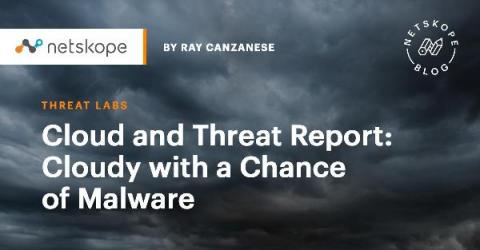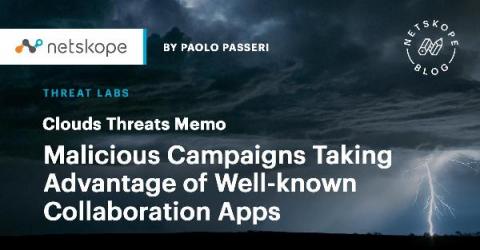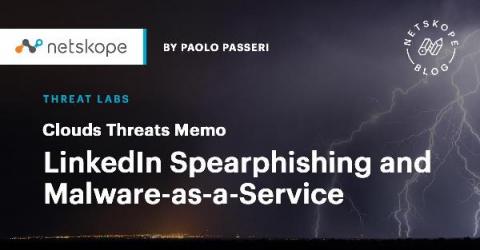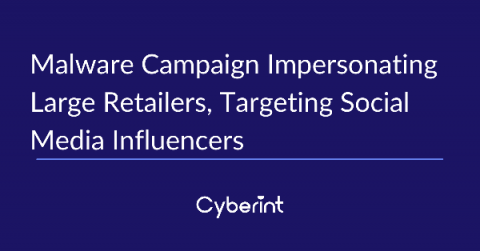Security | Threat Detection | Cyberattacks | DevSecOps | Compliance
April 2021
Cloud and Threat Report: Cloudy with a Chance of Malware
Cybercriminals are increasingly abusing popular cloud apps to deliver malware to their victims. In 2020, more than half of all the malware downloads detected and blocked by the Netskope Security Cloud platform originated from cloud apps. Cloud apps are commonly abused to deliver Trojans, with attackers attempting to exploit the trust placed in the app used for delivery. Increasingly, cloud apps are also abused for next-stage downloads, with attackers attempting to blend in with benign traffic.
FluBot: Malware as a Service Meets Mobile Phishing
Recently, Europeans were hit by an influx of SMS texts claiming to be package delivery notifications. It turns out these messages were orchestrated by threat actors seeking to distribute malicious apps laced with the banking trojan FluBot, also known as Cabassous. Once the victims download the malware, the app can intercept SMS messages, steal contact information and display screen overlays to trick users into handing over their credentials.
Devo Customer Story: Panda Security
REvil ransomware - what you need to know
REvil is an ambitious criminal ransomware-as-a-service (RAAS) enterprise that first came to prominence in April 2019, following the demise of another ransomware gang GandCrab. The REvil group is also known sometimes by other names such as Sodin and Sodinokibi. REvil has gained a reputation for attempting to extort far larger payments from its corporate victims than that typically seen in other attacks.
Pentest Crowd Spring Edition
Cloud Threats Memo: Malicious Campaigns Taking Advantage of Well-known Collaboration Apps
BazarLoader is a malicious dropper used in multiple campaigns, including the massive wave of attacks targeting US Hospitals with the Ryuk ransomware during October 2020. The primary purpose of BazarLoader is to download and execute additional malware payloads, and one of the key characteristics is its delivery mechanism, which exploits legitimate cloud services like Google Docs to host the malicious payload.
Netskope Threat Coverage: EtterSilent
Intel 471 researchers have identified a new malicious document builder, dubbed “EtterSilent,” leveraged by various threat actor groups. One of the build options is a weaponized Microsoft Office document (maldoc) that uses malicious macros to download and execute an externally hosted payload. The maldocs pose as templates for DocuSign, a cloud-based electronic signature service.
Cloud Threats Memo: LinkedIn Spearphishing and Malware-as-a-Service
‘More_eggs’ is a backdoor sold as a “malware-as-a-service” (MaaS) by a threat group known as “Golden Chickens” and predominantly used by three criminal groups: FIN6, Cobalt Group, and Evilnum. In the latest campaign, unearthed by researchers from eSentire and targeting a professional working in the healthcare technology industry, a threat actor is exploiting fake job offers on LinkedIn to deploy the ‘More_eggs’ backdoor on the victim’s machine.
Malware Campaign Impersonating Large Retailers, Targeting Social Media Influencers
Over the last few weeks, Cyberint has witnessed an ongoing attack campaign targeting social media influencers, attempting to infect them with malware by impersonating large clothing retailers. The campaign targets influencers across multiple social media platforms but currently appears to mostly focus on influencers operating on YouTube. Further, although the infection process is not sophisticated, it is notable and appears to be evolving.
A new headache for ransomware-hit companies. Extortionists emailing your customers
Cybercriminal extortionists have adopted a new tactic to apply even more pressure on their corporate victims: contacting the victims’ customers, and asking them to demand a ransom is paid to protect their own privacy. At the end of March, Bleeping Computer reported that the Clop ransomware gang had not stopped at threatening hacked companies and contacting journalists, but had taken the additional step of direct emailing victims’ customers whose details had been found in stolen data.











